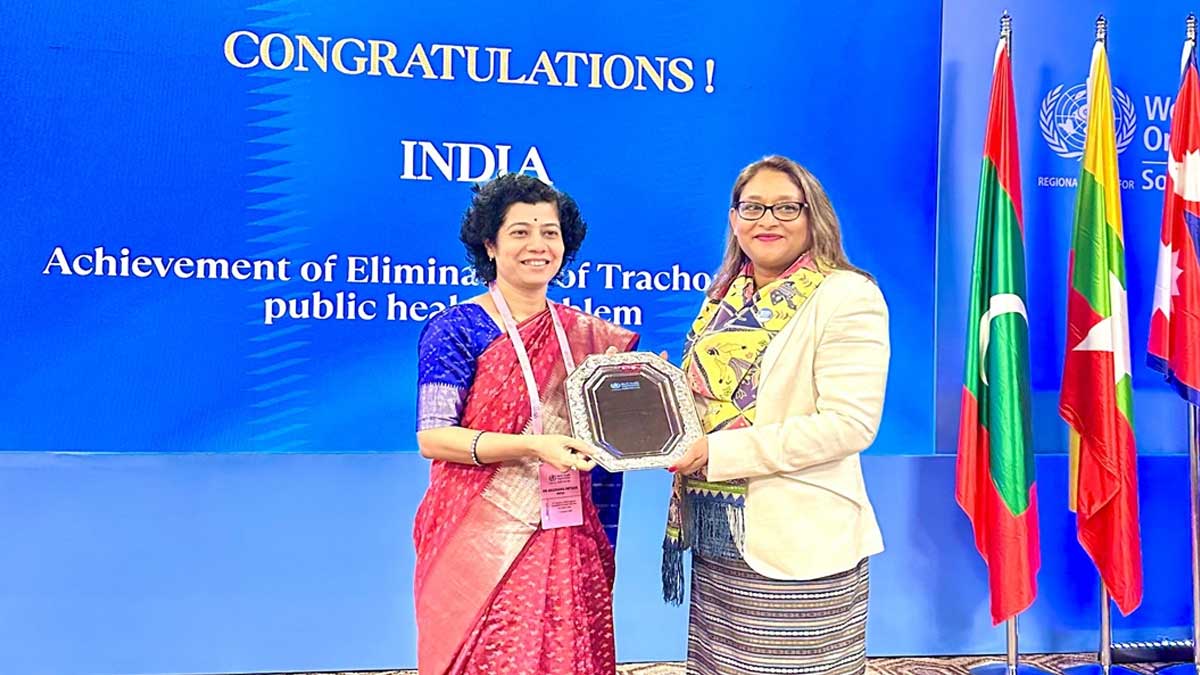The World Health Organization (WHO) has officially declared that the Government of India has successfully eliminated Trachoma as a public health problem. This significant milestone makes India the third country in the South-East Asia Region to achieve this status. The announcement was made during the WHO’s South East Asia Region Regional Committee meeting held in New Delhi.
Certification Ceremony
An official certificate recognizing this achievement was handed over to Smt. Aradhana Patnaik, the Additional Secretary and Mission Director of the National Health Mission, Ministry of Health and Family Welfare, by Ms. Saima Wazed, the Regional Director of WHO South East Asia.
Understanding Trachoma
Trachoma is a bacterial infection caused by Chlamydia trachomatis that primarily affects the eyes. The disease is highly contagious and spreads through contact with the eyes, eyelids, nose, or throat secretions of infected individuals. If left untreated, Trachoma can lead to irreversible blindness.
Global Impact
WHO has classified Trachoma as a neglected tropical disease, estimating that approximately 150 million people worldwide are affected, with 6 million individuals at risk of blindness or visual impairment. The disease predominantly affects underprivileged communities living in poor environmental conditions.
Historical Context in India
Trachoma was one of the leading causes of blindness in India during the 1950s and 60s. To combat this issue, the Government of India launched the National Trachoma Control Program in 1963, later integrating Trachoma control efforts into the National Program for Control of Blindness (NPCB).
Progress Over the Years
In 1971, blindness due to Trachoma was recorded at 5%. Through various interventions under the National Programme for Control of Blindness & Visual Impairment (NPCBVI), this figure has decreased to less than 1% today. The WHO SAFE strategy, which includes surgery, antibiotics, facial hygiene, and environmental cleanliness, has been pivotal in these efforts. In 2017, India was declared free from infective Trachoma.
Ongoing Surveillance
Despite this achievement, surveillance for Trachoma cases continued across all districts in India from 2019 until 2024. Additionally, the National Trachomatous Trichiasis (TT only) Survey was conducted in 200 endemic districts under the NPCBVI from 2021 to 2024, following WHO mandates to confirm the elimination of Trachoma as a public health issue.
Conclusion
All reports related to Trachoma were meticulously compiled by the NPCBVI team and submitted to the WHO country office for final review. After years of dedicated efforts, the WHO has officially declared that India has eliminated Trachoma as a public health problem.
Multiple-Choice Questions (MCQs):
1. What significant achievement has the Government of India recently accomplished regarding Trachoma?
a) Introduced a new antibiotic
b) Eliminated Trachoma as a public health problem
c) Increased funding for eye care
d) Established new eye clinics
Answer: b) Eliminated Trachoma as a public health problem
2. Who handed over the official certificate to the Indian Government?
a) WHO Director-General
b) Smt. Aradhana Patnaik
c) Ms. Saima Wazed
d) Indian Prime Minister
Answer: c) Ms. Saima Wazed
3. What is the primary cause of Trachoma?
a) Virus
b) Fungus
c) Bacterium
d) Parasite
Answer: c) Bacterium
4. What does the “SAFE” strategy stand for in Trachoma control efforts?
a) Surgery, Antibiotics, Facial hygiene, Environmental cleanliness
b) Surgery, Antiseptics, Facial cleanliness, Environmental support
c) Sanitization, Antibiotics, Facial hygiene, Education
d) Surgery, Awareness, Facial cleanliness, Environmental measures
Answer: a) Surgery, Antibiotics, Facial hygiene, Environmental cleanliness
5. How has the percentage of blindness due to Trachoma changed from 1971 to now?
a) Increased from 5% to 10%
b) Decreased from 5% to less than 1%
c) Remained constant at 5%
d) Increased to 15%
Answer: b) Decreased from 5% to less than 1%
